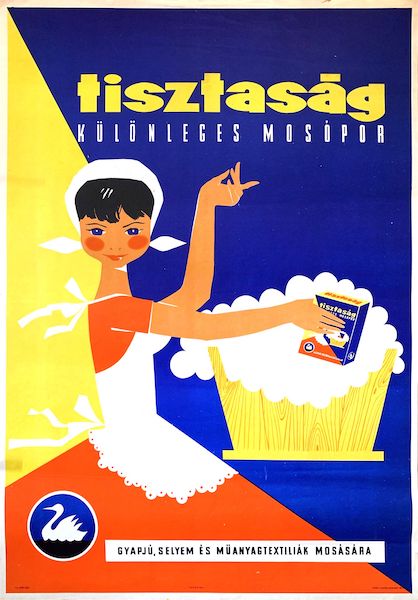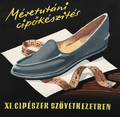
Purity Washing Powder
Hungarian title:
Tisztaság különleges mosópor régi plakát
Artist:
Unknown artist
Size:
A1 1 Sheet (cca. 84 x 59 cm)
Year:
1960
Condition:
Fine, light fold marks and wear, small tears and a very small paper loss at the bottom right border.
Material:
Paper, offset lithography.
Price: US$1000
Description:
Purity Washing Powder is a 1965 original Hungarian vintage commercial poster. Special cleanliness. Suitable for washing wool, silk and synthetic textiles.
In the 1960s a variety of household appliances appeared on the market that contributed to the easier and more efficient housework. Machines and related products such as washing powders were widely advertised. This poster has a simple, cartoon-like design with vivid yellow, red and blue colours. The simplified geometric forms and the bright white of the foam, the woman's apron and headscarf all point to the brand name and the product's purpose: Purity. Laundry detergent, or washing powder, is a type of detergent (cleaning agent) used for cleaning laundry. Laundry detergent is manufactured in powder and liquid form. While powdered and liquid detergents hold roughly equal share of the worldwide laundry detergent market in terms of value, powdered detergents are sold twice as much compared to liquids in terms of volume. From ancient times, chemical additives were used to facilitate the mechanical washing of textile fibres with water. The earliest recorded evidence of the production of soap-like materials dates back to around 2800 BC in ancient Babylon.
A washing machine (laundry machine, clothes washer, or washer) is a home appliance used to wash laundry. The term is mostly applied to machines that use water as opposed to dry cleaning (which uses alternative cleaning fluids and is performed by specialist businesses) or ultrasonic cleaners. The user adds laundry detergent, which is sold in liquid or powder form, to the wash water. Clothes washer technology developed as a way to reduce the manual labor spent, providing an open basin or sealed container with paddles or fingers to automatically agitate the clothing. The Industrial Revolution completely transformed laundry technology. Christina Hardyment, in her history from the Great Exhibition of 1851, argues that it was the development of domestic machinery that led to women's liberation. The mangle (or "wringer" in American English) was developed in the 19th century — two long rollers in a frame and a crank to revolve them. A laundry-worker took sopping wet clothing and cranked it through the mangle, compressing the cloth and expelling the excess water. The mangle was much quicker than hand twisting. It was a variation on the box mangle used primarily for pressing and smoothing cloth. Meanwhile, 19th-century inventors further mechanized the laundry process with various hand-operated washing machines to replace tedious hand rubbing against a washboard. Most involved turning a handle to move paddles inside a tub. Then some early-20th-century machines used an electrically powered agitator. Many of these washing machines were simply a tub on legs, with a hand-operated mangle on top. Later the mangle too was electrically powered, then replaced by a perforated double tub, which spun out the excess water in a spin cycle. Laundry drying was also mechanized, with clothes dryers. Dryers were also spinning perforated tubs, but they blew heated air rather than water. The earliest machines were hand-operated and constructed from wood, while later machines made of metal permitted a fire to burn below the washtub, keeping the water warm throughout the day's washing. An early special-purpose mechanical washing device was the washboard, invented in 1797 by Nathaniel Briggs of New Hampshire, though there were predecessors. By the mid-1850s steam-driven commercial laundry machinery were on sale in the UK and US. Technological advances in machinery for commercial and institutional washers proceeded faster than domestic washer design for several decades, especially in the UK. In the United States there was more emphasis on developing machines for washing at home, though machines for commercial laundry services were widely used in the late 19th and early 20th centuries. The rotary washing machine was patented by Hamilton Smith in 1858. As electricity was not commonly available until at least 1930, some early washing machines were operated by a low-speed, single-cylinder hit-and-miss gasoline engine. Laundry has been part of history since humans began to wear clothes, so the methods by which different cultures have dealt with this universal human need are of interest to several branches of scholarship. Laundry work has traditionally been highly gendered, with the responsibility in most cultures falling to women (known as laundresses or washerwomen). The Industrial Revolution gradually led to mechanised solutions to laundry work, notably the washing machine and later the tumble dryer. Laundry, like cooking and child care, is done both at home and by commercial establishments outside the home.











